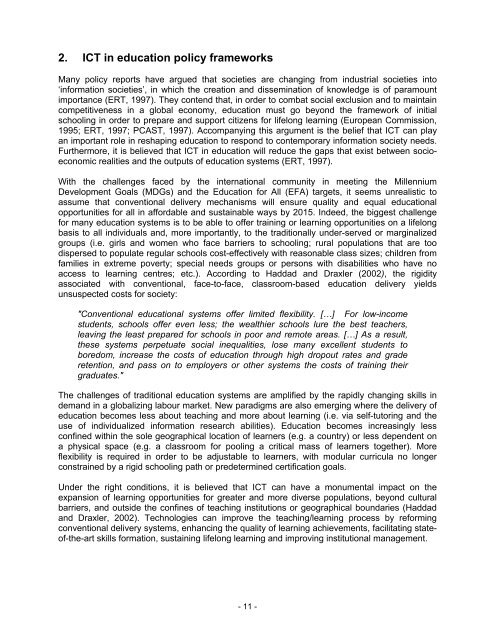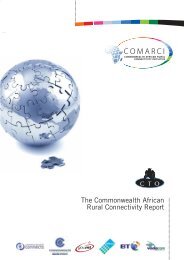Guide to measuring information and ... - unesdoc - Unesco
Guide to measuring information and ... - unesdoc - Unesco
Guide to measuring information and ... - unesdoc - Unesco
You also want an ePaper? Increase the reach of your titles
YUMPU automatically turns print PDFs into web optimized ePapers that Google loves.
2. ICT in education policy frameworks<br />
Many policy reports have argued that societies are changing from industrial societies in<strong>to</strong><br />
‘<strong>information</strong> societies’, in which the creation <strong>and</strong> dissemination of knowledge is of paramount<br />
importance (ERT, 1997). They contend that, in order <strong>to</strong> combat social exclusion <strong>and</strong> <strong>to</strong> maintain<br />
competitiveness in a global economy, education must go beyond the framework of initial<br />
schooling in order <strong>to</strong> prepare <strong>and</strong> support citizens for lifelong learning (European Commission,<br />
1995; ERT, 1997; PCAST, 1997). Accompanying this argument is the belief that ICT can play<br />
an important role in reshaping education <strong>to</strong> respond <strong>to</strong> contemporary <strong>information</strong> society needs.<br />
Furthermore, it is believed that ICT in education will reduce the gaps that exist between socioeconomic<br />
realities <strong>and</strong> the outputs of education systems (ERT, 1997).<br />
With the challenges faced by the international community in meeting the Millennium<br />
Development Goals (MDGs) <strong>and</strong> the Education for All (EFA) targets, it seems unrealistic <strong>to</strong><br />
assume that conventional delivery mechanisms will ensure quality <strong>and</strong> equal educational<br />
opportunities for all in affordable <strong>and</strong> sustainable ways by 2015. Indeed, the biggest challenge<br />
for many education systems is <strong>to</strong> be able <strong>to</strong> offer training or learning opportunities on a lifelong<br />
basis <strong>to</strong> all individuals <strong>and</strong>, more importantly, <strong>to</strong> the traditionally under-served or marginalized<br />
groups (i.e. girls <strong>and</strong> women who face barriers <strong>to</strong> schooling; rural populations that are <strong>to</strong>o<br />
dispersed <strong>to</strong> populate regular schools cost-effectively with reasonable class sizes; children from<br />
families in extreme poverty; special needs groups or persons with disabilities who have no<br />
access <strong>to</strong> learning centres; etc.). According <strong>to</strong> Haddad <strong>and</strong> Draxler (2002), the rigidity<br />
associated with conventional, face-<strong>to</strong>-face, classroom-based education delivery yields<br />
unsuspected costs for society:<br />
"Conventional educational systems offer limited flexibility. […] For low-income<br />
students, schools offer even less; the wealthier schools lure the best teachers,<br />
leaving the least prepared for schools in poor <strong>and</strong> remote areas. […] As a result,<br />
these systems perpetuate social inequalities, lose many excellent students <strong>to</strong><br />
boredom, increase the costs of education through high dropout rates <strong>and</strong> grade<br />
retention, <strong>and</strong> pass on <strong>to</strong> employers or other systems the costs of training their<br />
graduates."<br />
The challenges of traditional education systems are amplified by the rapidly changing skills in<br />
dem<strong>and</strong> in a globalizing labour market. New paradigms are also emerging where the delivery of<br />
education becomes less about teaching <strong>and</strong> more about learning (i.e. via self-tu<strong>to</strong>ring <strong>and</strong> the<br />
use of individualized <strong>information</strong> research abilities). Education becomes increasingly less<br />
confined within the sole geographical location of learners (e.g. a country) or less dependent on<br />
a physical space (e.g. a classroom for pooling a critical mass of learners <strong>to</strong>gether). More<br />
flexibility is required in order <strong>to</strong> be adjustable <strong>to</strong> learners, with modular curricula no longer<br />
constrained by a rigid schooling path or predetermined certification goals.<br />
Under the right conditions, it is believed that ICT can have a monumental impact on the<br />
expansion of learning opportunities for greater <strong>and</strong> more diverse populations, beyond cultural<br />
barriers, <strong>and</strong> outside the confines of teaching institutions or geographical boundaries (Haddad<br />
<strong>and</strong> Draxler, 2002). Technologies can improve the teaching/learning process by reforming<br />
conventional delivery systems, enhancing the quality of learning achievements, facilitating stateof-the-art<br />
skills formation, sustaining lifelong learning <strong>and</strong> improving institutional management.<br />
- 11 -
















